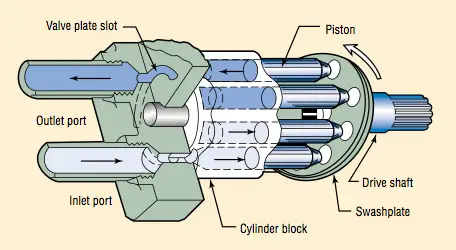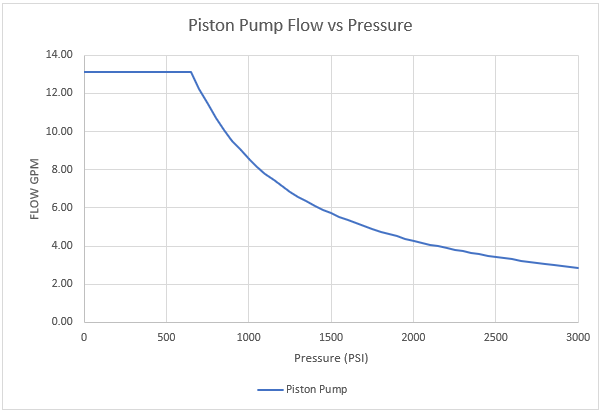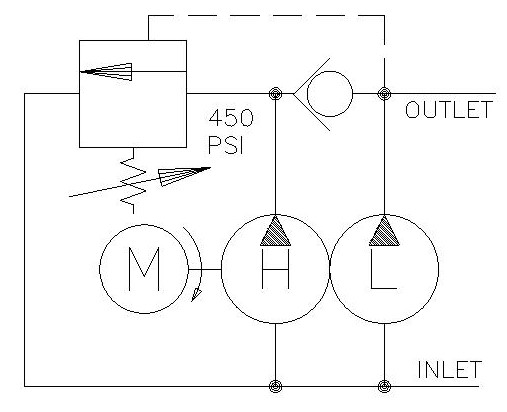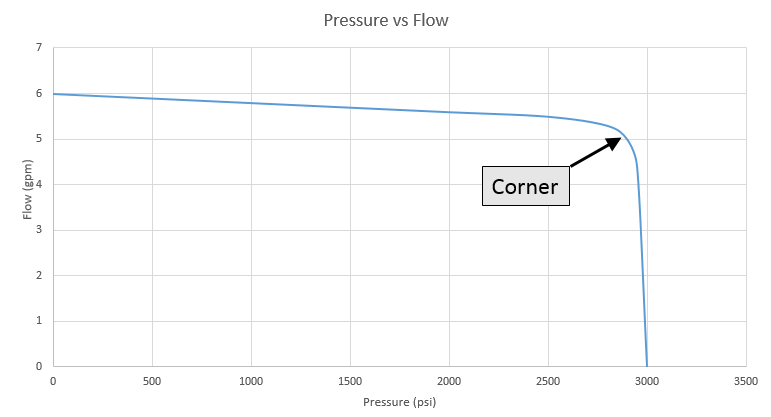Two stage pumps, often called log splitter pumps, are a great way to get better performance without increasing horsepower.
A two-stage hydraulic pump is two gear pumps that combine flow at low pressures and only use one pump at high pressures. This allows for high flow rates at low pressures or high pressures at low flow rates. As a result, total horsepower required is limited.
Watch This Video:
Before we can see how the two gear pumps work together, we first need to understand how a gear pump works.
Gear Pumps
A pump is simply a device that takes oil, usually from a reservoir, and moves it to somewhere else. Take note that a pump’s job is to move oil, not to create pressure. The pressure is a byproduct created outside the pump caused by resistance to fluid flow.
If you add a pressure gage to your garden hose you can experiment with this. If you turn on the hose with no attachments, you will see that there is very little pressure. This is because there is no resistance. When you start adding attachments or put your thumb over the end, you will see pressure build.
How to determine flow
Pumps are rated at their maximum displacement. This is the maximum amount of oil that is produced in a single rotation. This is usually specified in cubic inches per revolution (cipr) or cubic centimeters per revolution (ccpr). Flow is simply the pump displacement multiplied by the rotation speed (usually RPM) and then converted to gallons or liters. For example, a 0.19 cipr pump will produce 1.48 gallons per minute (gpm) at 1800 rpm.

Where Q is the flow in gallons per minute, Δ is the pump displacement in cubic inches per revolution and N is the number of revolutions per minute.

Simply put, gear pumps are positive displacement pumps and are the simplest type you can purchase. Positive displacement means that every time I rotate the shaft there is a fixed amount of oil coming out. In the diagram shown here, oil comes in the bottom and is pressurized by the gears and then moves out the top. The blue gear will spin clockwise. These pumps are small, inexpensive and will handle dirty oil well. As a result, they are the most common pump type on the market.
When I first had my log splitter, it had simple gear pump on it. The pump displacement was sized so that it put out the maximum horsepower the engine could at 3000 psi. As a result, it was incredibly slow!
I found that I was constantly waiting for the cylinder to stroke so that I could insert the next piece. I was really good at determining how much stroke I would need so that wasn’t wasting time over stroking the cylinder.
One day, the pump stopped working. Yea! I then looked to putting a larger pump and possibly larger engine on the splitter or even a regenerative circuit. But my mind also went to another type of pump, the piston pump.

A piston pump is a variable displacement pump and will produce full flow to no flow depending on a variety of conditions. There is no direct link between shaft rotation and flow output. In the diagram below, there are eight pistons (mini cylinders) arranged in a circle. The movable end is attached to a swashplate which pushes and pulls the pistons in and out of the cylinder. The pistons are all attached to the rotating shaft while the swashplate stays fixed. Oil from the inlet flows into the cylinders as the swashplate is extending the pistons. When the swashplate starts to push the pistons back in, this oil is expelled to the outlet.
To change the displacement, the angle of the swashplate is changed. The more perpendicular the swashplate is to the shaft, the smaller the flow. The pump displacement will diminish to zero as the outlet pressure nears the maximum system pressure.
Piston pumps can also have a torque limiting or horsepower limiting option. Torque limiting monitors the torque on the pump shaft and will minimize the displacement of the pump. Torque limiting allows the pump to output the maximum flow at any pressure which prevents your engine from stalling or a motor from burning up. This is quite common to see in applications where large amounts of fluid flow are needed at low pressures, but when operating at high pressures, the flow can be much less.
Why not use a piston pump?
A piston pump with horsepower limiting finds it’s almost ideal application on a log splitter. The piston pump will always be putting out the maximum flow at any given pressure while maintaining the same horsepower.
If we look at the usage of a log splitter, we find that essentially no pressure is required to move the cutter head to the log, but once contact is made, pressure builds and flow is reduced. The piston pump would provide all the flow we need at the low pressures and all the pressure we need at when splitting.

So why don’t we use a piston pump? Easy, it’s money. Lots of money. A piston pump is so much more expensive that it is not practical option. My mentor would say, “It is a golden machine that I cannot afford.” Gear pumps are inexpensive and reliable. You can get many gear pumps for the price of one piston pump.
So now the focus is turned to having two or more gear pumps that can be turned on or off. In most cases, you want to turn the pump off when pressures get to certain thresholds. This is exactly what a two-stage pump is. We have two pumps and turn one of them off when the pressure gets to a certain level.
So, we don’t actually turn one of the pumps off. It is very difficult to mechanically disconnect the pump, but we do the next best thing. So earlier in the article I mentioned that pumps move oil they don’t create pressure. Keeping this in mind, we can simply recirculate the oil from the pressure side back to the tank side. Simple. So, let’s look at this as a schematic.
Video Guide to Article:
How A Two Stage Gear Pump Works

We can see that our two pumps are always connected to the shaft and our motor or engine will turn the shaft. The pump on the left is the high displacement or high flow pump and the one on the right is the low flow pump. Since they are gear pumps, every revolution produces the same amount of fluid in the pressure port. At low pressures, the two flows are combined at the outlet as the high flow pump moves oil through the check valve. This gives us our high flow rate. In the log splitter, this would be used to run the system right up to the log that needs splitting. As the cylinder starts to exert force on the log, the pressure will build. At the current high flow, even medium pressures will stall out the motor. It is time to turn off the pump! It should be obvious to turn off the high flow pump, but I’ll make it clear: turn off the high flow pump.
Turning off the pump
Luckily, turning off the pump is quite simple and only involves two components: a check valve and an unloader valve. The check valve is there to keep the higher-pressure oil from the low flow pump separate from the oil in the high flow pump. The higher-pressure oil from the low flow pump will shift the unloader valve by compressing the spring. This allows flow from the high flow pump to return to the suction line of the pump. Many pumps have this return line internal to the pump, so there is no additional plumbing needed. At this point, the high flow pump uses little to no power to perform this action. You will notice that the cylinder speed slows dramatically. As the log splits apart, the pressure may drop causing the unloader valve to close again. At this point, the flows will combine again. This process may repeat several times during a single split.

The graph above shows the overlay of a performance curve of a piston pump and two stage gear pumps. As you can see, the piston pump between 700 psi and 3000 psi will deliver the maximum HP that our engine can produce and as a result, it will have maximum speed. Unfortunately, it will also have maximum cost. If we are willing to sacrifice a little performance, the two-stage pump will work very well. Most of our work is done under 500 psi where the two pumps have identical performance. As pressure builds, the gear pump will be at a slight disadvantage, but with good performance. The amount of time we spend in this region of the curve is very little and it would be hard to calculate the time wasted.

Looking at power consumed vs pressure tells us another benefit of using a two-stage pump. The piston pump gives us the best performance, but is almost always using the maximum power available. This means more fuel consumption. The single stage gear pump gives us the best fuel consumption, but the worst performance.
The two-stage gear pump gives great performance and is good on fuel consumption and price. It is the best all around choice when two distinct performance curves are needed.
After the pump on my log splitter died, I replaced it with a two-stage pump. While I was missing out on the full benefits of the piston pump, there was a tremendous increase in my output (logs/hr.). I noticed that instead of me waiting on the cylinder to be in the right position, I was now the hold up. I couldn’t get the logs in and positioned fast enough. What a difference!
Not just used for log splitting: While they are called ‘log splitter valves’, two-stage pumps are used in many other applications. Currently, I am working on a machine that uses a 6.5 cipr piston pump that is limited at 25 HP. We are having some issues with the pump and as a backup plan, we are looking at a multiple stage gear pump system to replace it. We are able to do this because we have clearly defined pressure and flow zones.
One drawback of a system like this is that when the pressure switches from one zone to another, the flow will change dramatically. This can create problems of unintended motion especially if the pressure might cross the threshold many times.
For the example given above, it is similar to a log splitter in the way that it needs large pressures to break an object free and then lots of flow to move it quickly. There are other functions, but they can operate in the higher-pressure zone with minimal performance impact. One benefit in this design is that I can actually increase my flow in the low-pressure zone from 50 gpm to 60 gpm (or even higher).
Not only two stages. Another thing to not lose sight of is that you can have more than two stages. Many times, two stages will work great, but there might be another intermediate stage that needs to be added. No problem. You can add as many pumps as you need and have the unloader set for each as needed. I recommend getting pumps that can be close coupled so that there is no need for shaft couplers.
As you go from a standard two-stage pump to your own custom design, you will find that you will need to add the check valve and unloader separately. However, there are many available cartridges manifold out there already that make this simple. Some even have relief valves built in!
How to Determine if your Hydraulic Pump is Working Properly

Conclusion
Two stage pumps are wonderful creations! They allow for better utilization of pressure, flow and power by giving you two performance curve areas. They also show their versatility in conserving power which leads to energy savings while remaining inexpensive. A lot of these pumps come pre-made and preset, but you can make your own! See if your next project can get a boost from one of these wonderful devices.

